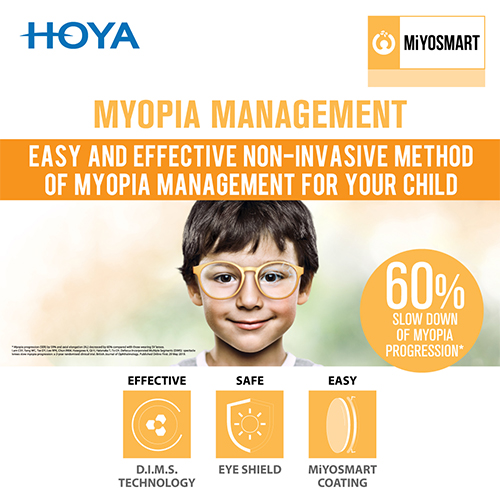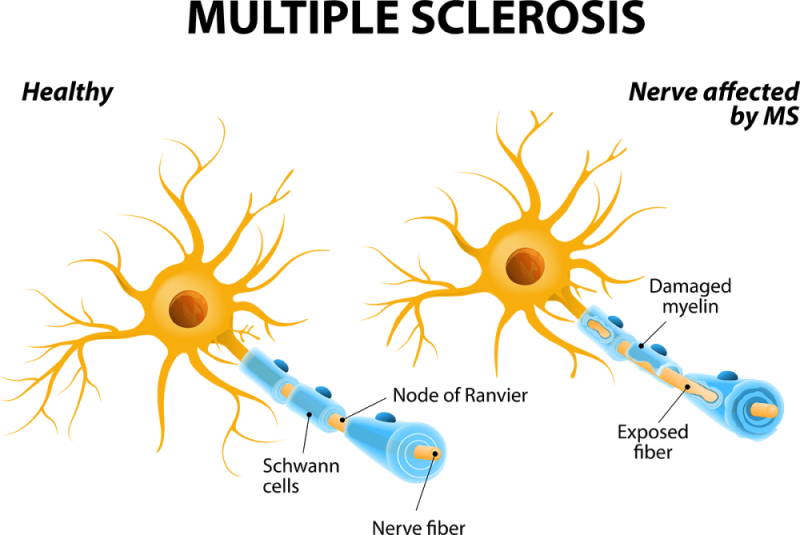Myopia (nearsightedness) is a type of refractive error of the eyes where close objects appear clear, but distant objects appear blurry.iMyopia commonly has its onset in childhood.iiAccording to the United States Centers for Disease Control and Prevention (CDC) myopia is the most common refractive error for those younger than 59 years old.iiiIn the United States, the prevalence of myopiahas grown to more than 40 percent andhas been predicted to be more than 50 percent by the year 2050.ivWith these soaring rates of myopia comes an increase in vision threatening ocular diseases and increased risk of visual impairment which adversely impactshealth carecosts,human productivity and quality of life.vApublic healthurgencyexists toaddress children’s vision healthin the U.S., including a need to provide coordinated surveillance systems and access to comprehensive child visionand eye healthcare in every state.viClinically, while the myopia is not an infectious disease, there is precedent to monitor conditions and behaviors that are risk factorsfor injuries and other chronic conditions, andto respond with appropriate publichealth control measures.viiDiagnosis and treatment of myopia is more than just “needing glasses.”Myopia isa diagnosed health condition that isassociatedwith comorbidities that increase the risk of severe and irreversible loss of visionincluding retinal detachment, subretinal neovascularization,myopic macular degeneration, dense cataract, and glaucoma. Importantly, undiagnosed myopia does not need to be present at high levels to result in adverse health outcomes. Any level of undiagnosed myopia can be considered a risk factor forother diseases and/or conditions which may be amenable to treatment.Allnewborns are born with vision that is out-of-focus at a distance. If humandevelopment proceeds appropriately (providing that light is focusing properly on each retina), babies normally gainclear vision in the first few months of life. As a child grows, like the rest of the body, the eye is expected to appropriatelyincrease in lengthand size. This is the process of emmetropization. Normal vision-meaning vision which is clear at full distance (20 feet/6 meters and beyond), absent ofanyrefractive error(i.e. myopia, hyperopia, astigmatism) is clinically called emmetropia.Light entering the emmetropic eye focuses perfectly on the retinain all planes, and the child is able to focus and see targets clearly at a distance.Because ofmodifiable and non-modifiable environmental factorsand genetics, this normal process can be interrupted, becomingdysfunctionalandresulting in anametropic environment(when light enters the eye and does not focuses perfectly on the retina).In primary eye care, there are predominantly threeclinically diagnosed forms of ametropia:myopia, hyperopiaand astigmatism. If light comes to a focal point in front of the retina, the individual’s eye is diagnosed with myopia. If light comes to a focal point behind the retina, theindividual’s eyeis diagnosed with hyperopia. If light comes to two different focal points, the individual’s eyeisdiagnosed with astigmatism.The larger the distance between the focal point of light and the retina, the larger the diagnosed magnitude of myopiaor hyperopia.
Physiologically,myopiacan occur in two ways:1)because ofthe optical system having increased focusing power(i.e. from cornea or lens),or 2)the eye growing too long(axial length of the eye) during normal development, because ofocular disease,or a combination of any of those.Ametropia, detected through a comprehensive eye examination, is a diagnosed clinical sign of an abnormal and potentially unhealthy/diseasedeye.According to the United States Food and Drug Administration (FDA) report from the workshop: Controlling the Progression of Myopia: Contact Lenses and Future Medical Devices, the suddenincrease in myopia prevalencesuggests an environmental(including cultural)influence.viiiOf notehas been the recenttrend toward morenear vision tasks associated with the significant increase in use of smartphones and tablets, especially in the pediatric population. At a time where the natural physiologicemmetropization process of the eye is occurring, children on average are spendingup to sixhours per dayixon handheld screens. This unnatural and continuous near point stimulus is a highly suspected factor in rising rates of progressive myopiaand rising rates of Type 2 diabetes in children. Increasing screen time is usually accompaniedwith a lack of outdoor timeand more sedentary lifestyle. Guidelines on Physical Activity, Sedentary Behavior and Sleep, recently released by the World Health Organization, call for no more than one-hour screen time for children age 2 through age 4,and no screen time for children less than one year of age.xA lack of outdoor timehas been shown to be a myopia-genic factor. As such, there is a known protective effect of increasedoutdoor time for onset of myopia.xiThe more time children are inside reading, studying and using their electronic device(s), the less natural light the eye is receiving to develop properly.Importantly, a neurotransmitter called dopamine is stimulated by the sun. Animal models show that dopamine controls the elongation of the eyesand keeps the eye from growing as much.Ifa child does not have enough dopamine due tositting inside, then the eye can get longer and longer, and the longer the eye, the more severe the myopia. Tohelp protect their eyesight, childrenprobably should partake in anywhere from one to three more hours of outdoor activity a day.xiiIncreasing time outdoors may be associated with a reduced risk of myopia and myopic progression.xiiiEthnicity is an important factor in myopia prevalence and progression. Children of East Asian ethnicity have a faster myopic progression rate and demonstrate more robust outcomes with interventions aimed at slowing the progression of the condition. While ethnicity is a risk factor, so toois being a biological sibling of an individual with myopia.Genetic effects appear to have the major role in determining the similarity of refractive error between siblings.xivFortunately, when myopia is diagnosedthrough eye examination by an eye doctor, several clinical treatment and management methods have been identified and may be prescribed by the doctorof optometry to control the progression of myopiain individuals in children and adolescents.xvProgressive Myopia Treatment ModalitiesTreatment strategies to reduce the rate of myopic progression would be beneficial in avoiding some of myopia’s effects on public health.xviApositive noteforthe treatment of progressive myopia in children is the safety profile of the use of hard (rigid gas permeable) or soft contact lenses. The incidence of corneal infiltrative events in children is no higher than in adults, and in the youngest age range of 8 to 11 years, it may be markedly lower. By this standard, contact lenses arerelativelysafe to use in children.xviiOrthokeratology(Ortho-K) StyleContact LensesThese special contact lenses are designed to reshape/moldthe cornea overnightto temporarily reduce the corneal powerand myopia once they are removed.Ortho-K lenses (think orthodontic retainersfor the eye/cornea) areprimarily worn during sleep (peripheral defocus modifying design).This in turn enables the wearer to be free of spectacles or contact lenses throughout the day. For those involved with activities where spectacles or contact lenses are contraindicated (such as swimming or contact sports), the corneal molding method is quite beneficial.xviiiSoft multi-focal contact lensesworn during waking hours(peripheral defocus modifying design)These contact lenses have been shown to be quite effective in controlling myopia since the early 1970s. Both concentric ring bifocals and peripheral add multifocals have shown significant efficacyand are proven clinically effectivein controlling myopic progression relative to control groups. Today, there are daily disposable soft contact lenses that are available for myopia management (off-label use in the United States, on-label in Europe).Atropineeye dropsare used to dilate(open)the pupils and fully relaxthe focusing power(accommodation)of the eye (i.e. cycloplegia)and hasbeen used for myopia control for some years. Studies have shown its effectiveness in a concentration-dependent response. While varying strengths (0.05%, 0.025%, and 0.01%) atropine eye drops reduced myopia progression, 0.05% atropine was most effective in controlling myopia progression and eye elongation.xixParticular attention must be paid to higher concentrations of atropinedue to it being a nonselective muscarinic antagonist. Patients/parentsmust be made aware of the off-label use of thesedrugs,as well as all possible side effects. Spectacles, whether in distance, near, bifocal or progressive design,have not been shown to be clinically effective in the management of progressive myopia.xxIn summary, all health care professionals, teachers, school nurses, legislators, public health officialsand especially parents need to be keenly aware of the environmental and genetic challenges our youth faces today, including the near epidemic rise of myopia and myopia related ocular disease. Regular in-person comprehensive dilated and cycloplegic eye examinationsby an eye doctorare necessary for all childrenbetween the age of 6months to 12months and between age 3and age 5. The specific timeline of eye examination for children and adolescents has been detailed in the American Optometric Association Evidence Based Clinical Practice Guideline on the Comprehensive Pediatric Eye and Vision Examination.xxiFrom a public health perspective, the economic burden of undiagnosed myopia and related vision loss is massive. Intervention at an earlierage can likely prevent the worsening of myopia and myopia related vision loss. Doctors of optometry are extensively trained both didactically and clinically in pediatric (infant, 4toddler and children’s) eye care to beuniquely qualified to managemyopia and related eye and vision health concerns.xxiiAs such, interprofessional referrals from pediatricians, nurses, behavioral/mental health and other health care providers (who assist the identification of vision problems) to doctors of optometry, should be common.With large gaps in vision and eye health data recorded among individuals age 18 and younger, surveillance systemsshould be put in place to monitor and record refractive and eye health status of all children and adolescents. Doctors of optometry are accessible in counties where 99 percent of the U.S. population resides.xxiiiFortunately, intervention and prevention methods are painless and very accessible to the public.As myopia becomesmore prevalent, management and treatment need to become much more common.





Recent Comments